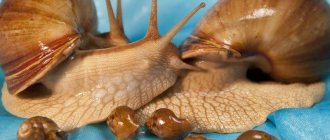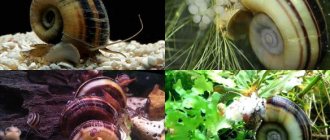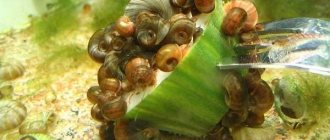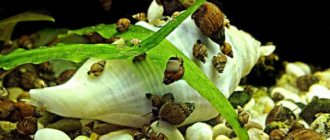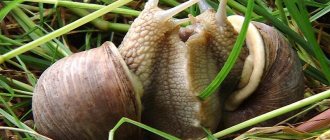To an experienced aquarist, the food preferences of the inhabitants of a home pond seem simple and understandable. He can tell you in a nutshell what types of aquarium animals pose a danger to their “neighbors” and whether snails can eat fish. But for those who have never kept an aquarium at home before, the processes occurring in it are complex and incomprehensible. Many beginners are concerned about the question of who eats snails in the aquarium. Let's figure out who can threaten shellfish in a home pond.
Predators
Any snail is a scavenger. There is also a softer definition for her - an aquarium orderly. In fact, mollusks maintain the ecosystem of the reservoir in good condition. They eat the dead fish, and sometimes they even start to “feast” when the poor fellows are still alive, but very weakened.
If the owner of an aquarium notices a fish lying on the bottom being eaten by snails, you should not blame the mollusks for its death. They are just performing their sanitary functions. This process is natural and should not be alarmed. Nature has provided for everything, but you shouldn’t rely on the snails themselves to deal with the remains of the unfortunate fish. The remains must be removed from the aquarium as quickly as possible. Especially considering that the fish could have been infected with some kind of virus, which is why it died. If the deceased individual is not immediately removed from the reservoir, the rest of its inhabitants may also become infected.
You should always remember that a slow snail will not eat live and healthy fish. Especially considering the speed of movement of the latter. Therefore, shellfish can be safely kept in the same container with other living creatures.
Diseases
usually causes incorrect content.
- Problems with the sink due to lack of calcium.
What to do? Provide quality care.
Why does the ampularia's shell collapse ? She doesn't have enough calcium. You can help by adding natural chalk, a shell or an eggshell to the water. Be sure to chop! It’s a good idea to put a sepia (cuttlefish skeleton) in the aquarium. It contains a lot of proteins. It is easy for snails to scrape it off.
- Ticks. Symptoms of the disease: depressions on the shells.
What to do? The following procedure will help. Remove the snail from the water and wipe the shell with a soft cotton cloth. Soak a cotton swab with a solution containing formaldehyde (for example, anti-steam) and wipe the sink.
If signs of the disease are found on one ampullary, all individuals must be subjected to preventive treatment.
- Other parasites can also live on snails. Sometimes a white coating, similar to fluff, appears on the shells.
Place your pet for 15 minutes (no more!) in a salt solution: 10 g. per liter of water.
- Coma. Happens due to poor maintenance in the aquarium. The animal lacks oxygen. Symptoms: the snail is alive, but does not crawl out of its shell. Place the ampularia in a glass jar with water.
Who eats snails in an aquarium
We have already figured out why snails eat fish in an aquarium. And who eats the snails themselves?
Some aquarium fish are not at all averse to treating themselves to shellfish. For example, gouramis, most species of cichlids and goldfish consider shellfish a “delicacy.” Shrimp can also afford such a treat. Therefore, if one of the aquarium inhabitants begins to show increased interest in ampullaria or another mollusk, it is advisable to transfer the latter to another container or return it to the store before it is eaten. Usually fish do not calm down until they complete their task. Therefore, if the mollusk is not saved in time, it will be doomed.
But there are aquarists who breed snails specifically for feeding to fish. This way they save on buying food and add variety to their pets’ diet. At the same time, there is always confidence that the mollusks grown for food are healthy and cannot infect the fish with anything.
Compatibility with other aquarium inhabitants.
Ampularia is peaceful, but can destroy fish eggs.
Compatibility with other fish
You asked whether it is possible to keep ampularia and helen together. Adults get along well with each other. Helena's newborn clams will be eaten. Will not cause harm:
- catfish
- any species of characin fish (distichod, alestes, tetra)
- uaru (although it belongs to the cyclid family)
- telescope
- denmark pink
- Congo
Capable of injuring or destroying:
- red-eared turtles
- crayfish and shrimp
- any types of barbs
- cyclides
- all types of tetradons
Fish that eat snails
Knowing which fish eat snails in an aquarium is useful for those who want to get rid of annoying gastropods without resorting to chemicals. But in order for the fish to become interested in shellfish, it should not be well fed.
- Ancistrus dolichopterus. Its diet consists of primitive algae. But at the same time, while cleaning the walls of the aquarium, the catfish eats snail eggs. It will not completely rid your home pond of weeds. But it will help to significantly reduce their number and prevent their rapid reproduction.
- Clown botia (Chromobotia macracanthus) is the most famous species of botia. Its second name is macracantha. This fish is very fond of snails and eats quite large specimens, although it will not refuse caviar.
- Marbled botia (Botia almorhae). This fish will be useful for those who do not want to get rid of snails completely, but want to reduce their number.
- Eight tetradon (Tetraodon biocellatus). He loves to dine on snails and at the same time eats them all indiscriminately, including the coil, the fisa, and even the sand melania, which hides in the thickness of the soil.
- Green tetraodon (Tetraodon nigroviridis). It can be called a real exterminator of different types of mollusks. A fish whose size is 15 cm can cope even with large ampullaria.
- Dwarf gourami (Trichopsis pumila). An undemanding fish that eats not only small snails, but also their eggs, which is rare.
- Dwarf tetradon (Carinotetraodon travancoricus). Like any type of tetradon, it requires constant grinding of its teeth, for which it uses mollusk shells. Therefore, snails are vital for this fish. The fastest way to control it is with physical and reel. To prevent the entire population of these snails from being destroyed in 2 days, the dwarf tetradon should be fed.
- Macropod (Macropodus opercularis). It eats weedy species of mollusks, as well as hydras and planarians with great appetite. But he does this exclusively on an empty stomach. This fish also does not ignore shrimp, so it should not be put into shrimp tanks.
Pelvicachromis pulcher. The bright color of this fish gave it a second name - “Parrot Cichlid”. She requires protein food, so her diet consists of insects, larvae, and fry of other fish. If all this is not nearby, pelvicachromis will start eating snails.
Striped Platydoras (Platydoras costatus). When there is enough food in the aquarium, this fish is not interested in gastropods. But the feeling of hunger forces her to eat weed mollusks, which she manages to suck out of the shell. In addition, striped platidoras are real orderlies of the aquarium and, in addition to gastropods, they also eat various parasites. The nocturnal activity of this fish allows it to deal well with melania.
Description of Ampularia
| Kingdom | Animals |
| Type | Shellfish |
| Class | Gastropods |
| Squad | Mesogastropods |
| Family | Ampullariidae |
| Genus | Pomacea |
Almost no different from its relatives in the prosobranch subclass. All of them belong to the class of gastropods.
This is an invertebrate animal with a well-developed sense of smell.
Appearance
The snail's body has a head with a pair of tactile tentacles, a leg and an internal sac. The bag is covered with a spirally curled shell. The long muscular leg is used for movement. On the back there is a lid that seals the mouth of the shell in case of danger.
The size of the aquarium ampoule depends on the species and can range from 5 cm to 15 cm.
The complex respiratory system is of interest. The snail has gill slits on the right side. They supply oxygen dissolved in water. On the left side are the lungs. Ampularia lives under water. But about once every ten minutes she needs to receive atmospheric oxygen. To do this, the animal rises to the surface, extends the breathing tube-siphon and rhythmically sucks in air.
Instead of jaws, snails have special graters - radulas. They use them to scrape off food.
There are eyes. But mollusks hardly see. They can only distinguish a dark object from a light one.
Types of snail
Attracts with its variety of colors. In nature, the shell of the mollusk is light brown. Selection has achieved a wide range of colors. White, black, and blue ampoules are not uncommon. The shells are often decorated with stripes of lighter shades.
The most common color is yellow.
The genus Pomacea includes several dozen species.
They differ from each other in the size and shape of the shells.
Fans of aquarium snails are familiar with golden, Australian and giant Pomacea.
Golden ampularia
Named for the color of their shell. Several morphs are popular among hobbyists.
- Pomacea bridgesi is called the mystery snail. The adjacent coils of the shell have flat slopes. Bridgesi can reach seven centimeters. Another popular name is Cinderella. But not for the yellow color of the shell. They spend time in the aquarium in constant work: scraping growths from the walls, removing rotting algae.
- Pomacea canaliculata has a rounded shell. One turn seems to creep onto another. The snail grows up to eight centimeters.
- Marisa comuarietis differs from its fellows in its unusual appearance. It's called a giant coil. The shell, about 3 cm in diameter, has dark stripes. But it can also be monochromatic. The coils are located in the same plane.
- Pomace apaludosa is a resident of Florida and is rarely found in Russian stores. It has a cone-shaped top. Its size ranges from 4 to 6.5 cm
Giant ampullaria
.
Rare representatives of the class are impressive in size. The shell reaches a diameter of 10-12 cm. The leg is up to 15 cm. The only species whose color depends on age. Babies are born black (sometimes brown). As it grows, the shell becomes lighter and yellow stripes appear. The giant ampularia has beautiful golden eyes. It is rightfully considered the decoration of an aquarium.
Australian ampullaria
Large snails with a keen sense of smell and wonderful eyes. The leg length of an adult reaches up to 9 cm. The diameter of the shell is 7 cm. It loves aquariums overgrown with algae. The complete absence of vegetation will not upset her either. The snail will eagerly consume the remaining fish food.
Fans of the aquatic world appreciate Pomacea for its decorative qualities and unpretentiousness.
Turtle
Do turtles eat snails? In the diet of many species of turtles, mollusks are present on a regular basis. They do not refuse any aquarium inhabitants, including ampularia, neretina, melania, marise, etc. If the gastropod has a conical shell, you need to break off the tip, and then offer the mollusk to the turtle.
Snails are also grown to feed turtles, but under no circumstances should they be given mollusks from open bodies of water (meadows, pond snails). They accumulate a large amount of harmful substances in their bodies, and are also often intermediate hosts of certain types of parasites that can also live in turtles.
Reproduction
Sex differences
It is difficult to identify snails by their appearance.
The reproductive organ is located on the right side under the shell. Sex can be determined during mating. The snails seem to stick to each other. The female is always on the bottom.
Snails reach sexual maturity at about a year or a little later.
For breeding you will have to purchase four to five individuals. Then there is guaranteed to be a male and a female among them.
Getting offspring
Breeding of ampularia occurs by laying eggs. This is done by the female ampularia out of the water. In nature, it uses stones, stems, and tree branches for masonry. The exception is Marisa comuarietis. The snail lays eggs at the bottom of the pond.
In captivity, in the evening the female crawls out onto the glass that covers the aquarium. Less often on the walls. In any case, you should take care of at least ten centimeters of free space. You can drain some of the water.
The ampoule lays eggs one at a time, gluing them to the glass. They emerge along the genital fold located on the leg of the mollusk. The snail moves them and compacts them slightly. It turns out to be a kind of bunch the size of a little finger.
Do I need to create a special place for masonry ? There is no need for this. The snail will make the decision itself. An important point: ampularia often lays eggs under a lamp. It's warmer there. The masonry may dry out and die. It must be carefully cut and placed on any floating surface (for example, a piece of foam).
In the first minutes, the caviar is soft to the touch and pinkish. The shell then hardens when exposed to air. Later the color changes. The bunch turns bright orange or dark green, sometimes white. Shortly before the offspring emerge, it gets dark.
Babies are usually born in fourteen days. But they may delay up to a month. This depends on the ambient temperature.
Two dangers immediately await them.
- All the inhabitants of the aquarium are not averse to eating young mollusks. Their shell is soft.
- Having come off the glass, the ampularia fall into the ground. Not everyone can get out of it.
The problem can be solved by placing a fine mesh net under the eggs. Small snails are placed in a glass container.
They are fed softened dry food and plants (hornwort, Java moss).
Reproduction usually occurs in the warm season. Less often, snails give birth in winter.
Diseases characteristic of guppy
Guppies, like many phenotypes, have individual diseases characteristic only of this species. Specific ailments of guppies are:
- Tetrachymenosis - the initiator of the disease is a ciliated ciliate, which penetrates first into the gills, then into the body of the fish and leads to the death of guppies. Symptoms of the disease appear in the form of mucus, ruffled scales, and protruding gills. With tetrachymenosis, the caudal fin is destroyed and the abdomen is swollen. You can cure sick pets with bispetol, dissolved in a proportion of 2 tablets per 100 liters of water, or furazolidone - 1 g per 100 liters.
- Guppy disease is a characteristic ailment in which white spots appear on the body of the fish and the scales become ruffled. With this disease, the guppies lie on the bottom, refuse to eat, become weak and lethargic. Treatment is carried out in formaldehyde baths, using a new solution each time, since the old one will harm the fish.
Calcium in nature
Calcium occurs in nature only in the form of compounds, such as limestone (calcium carbonate), gypsum (calcium sulfate) and dolomite. Snails need feeding containing calcium carbonate with the chemical formula CaCO3. Calcium carbonate is the main component of limestone, marble, chalk, and is also part of egg shells.
In their natural environment, snails detect calcium and other food through their respiratory tract (olfactory cells).
Calcareous soils, dead animal bones, empty shellfish shells, and some plants are sources of calcium.
Preparing the aquarium for polishing.
When polishing at the installation site: by agreement, we can provide a sufficient number of canisters and other containers, absolutely clean, for transferring decorative elements, soil, plants, fish and animals into them. The aquarium is washed inside and out, wiped with a clean cloth, and scratches are marked with a marker. At the end of the work, everything returns to its place. If we transport the aquarium to the workshop, we can accept fish and animals for foster care in our aquarium farm. We can also hold marine inhabitants and living rocks.
Why does a snail need calcium?
Snail shells are mainly composed of calcium carbonate CaCO3 and a binding protein (conchiolin). As the mollusks grow, they secrete a substance that increases the size and thickness of the shell. This substance is secreted by glands on the skin fold - the mantle, and it consists mainly of calcium carbonate. Essentially, snails consume calcium, process it and grow new coils, which is how shells grow. That is why young individuals and mollusks with damaged shells need increased amounts of this substance.
Calcium is also necessary for the formation of healthy egg clutches.
Snails receive this useful substance not only from food, but also absorb it through the sole of their feet when crawling.
Guppy swims belly up
There are many reasons why a fish can swim belly up, here are some of them:
- Viral or bacterial infections;
- Infestation with parasites;
- Cancer or fungal diseases;
- General weakness;
- Starvation;
- Fin or swim bladder disease;
- Increased gas formation in the gastrointestinal tract.
But the main reason should be considered inflammation of the bladder - this is a contagious disease that is caused by infection. The disease was first identified in the 50s. Infection occurs due to poor quality food and improper aquarium conditions.
Forms of the disease:
- Acute – occurs in severe form, lasts 6-7 days. The guppy stops eating, falls over on its side or upside down, and begins to float belly up. The internal organs begin to become inflamed, and curvature of the spine occurs. The bladder becomes covered with purulent ulcers, which gradually penetrate inside. The fish lose a lot of weight and die.
- Chronic – is not so acute, lasting about a month. Guppy eats, but very little. Inflammation of the organs and bladder becomes purulent. The bubble gradually changes its shape and due to lack of oxygen, the fish swims close to the surface with its belly up.
If you start treating your fish as soon as the first symptoms appear, the prognosis may be favorable. During the treatment period, guppies must be left without food, this will help stop the inflammation process.
Why do fish fall on their sides?
Strange behavior of fish is almost always associated with various pathologies. Therefore, the fact that a guppy is swimming sideways should alert you, as this is a sign of a very dangerous disease - glucose disease. Another characteristic symptom is severe bulging eyes, which can only be on one side.
The cause of the disease is intracellular parasites - sporozoans, which multiply very quickly and begin to affect all internal organs: intestines, liver, gills and eyes. This happens due to the accumulation of parasites in the muscles and connective tissues.
As soon as it is noticed that the fish is lying on its side and is reluctant to swim, it is urgent to establish the reason for this behavior. Since glutenosis is not a curable disease, all fish will die if infected. If the diagnosis has been confirmed, then all contents of the aquarium must be destroyed and the aquarium thoroughly disinfected.
To avoid infection of all inhabitants of the aquarium, it is always worth keeping new fish in quarantine and only after making sure that the new pet is healthy can it be transplanted into the general aquarium.
Choice of partial or complete replacement
Most aquarists recommend using partial replacement . Tap water has a softer composition. At the same time, it contains a large number of trace elements, minerals, and beneficial substances that have a beneficial effect on the life of fish.
It contains much less carbonates, so most individuals survive in it.
If you combine spring and tap water at the same time, you get a mixed composition, saturated with useful elements and minerals. But at the same time, the water will remain soft.
It will have an optimal ratio of acids and alkalis, so the composition is more neutral. In such an environment, normal breathing, reproduction, and vital activity of fish are possible.
Analysis before adding
To find out the parameters, a full chemical analysis is carried out. It includes the following indicators:
Acid-base state.- General mineralization and composition of each substance separately.
- The ratio of organic and inorganic substances.
- Rigidity.
- Petroleum products, phenols, surfactants.
- Minerals - aluminum, beryllium, barium, boron, iron, manganese, cadmium, copper, molybdenum.
Every city in Russia has laboratories that determine the chemical composition of liquids, including water from a spring source.
Quick results are obtained in private laboratories . You can find them through the Internet search page. A query is entered into Google or Yandex for a chemical analysis of water for a specific city.
The best indicators are issued by officially accredited organizations. Such laboratories will be able not only to perform an analysis, but also to take a high-quality sample.
Calcium for Achatina snails
Many owners of exotic pets are interested in which calcium to choose for Achatina snails. The most popular and affordable option is eggshells. It is first ground into powder in a coffee grinder, and then sprinkled on plant foods or included in the calcium mixture. The shells of both boiled and raw eggs are used.
Sepia or cuttlefish shell is also actively used by snail breeders. Achatina really likes this source of calcium, and they happily gnaw on it. Only cuttlefish shell is not very cheap and cannot be found everywhere. In addition, it is necessary to pay attention that the sepia is not salty, and desalinate it if necessary. Read more about sepia here.
You can also use shell rock or natural chalk. Only pure chalk, without impurities or additives, is allowed to be fed to snails. If you want to offer bird stone to your shellfish, then first study the composition. And, if it does not contain substances harmful to snails, then feel free to feed your pets. But it’s not a fact that they will attack chalk after eggshells or sepia.
What can be used
To prevent your pets from experiencing any of the above, it is necessary to provide them with a high-quality source of calcium.
Suitable substances contain approximately 75% CaCO3.
Other substances, for example, MgCO3, vitamins and minerals - iron, folic acid, phosphorus, will not harm shellfish, but copper should be avoided, since it is very toxic even in small quantities.
Sources of calcium for snails can be:
- Shell rock (limestone);
- dolomite flour;
- natural chalk;
- sepia (cuttlefish shell);
- egg shells;
- shells of other mollusks.
Almost all of these products can be purchased at pet stores. When purchasing, be sure to pay attention to the composition, which should not contain salt.
Some shellfish keepers use tricalcium phosphate. Only this supplement must be fed in a mixture with another source of calcium from those listed above. It is not recommended to feed it in its pure form.
Sepia and natural chalk do not need to be crushed, but simply placed in a terrarium; snails can easily gnaw them. But other types need to be ground to a powder, mixed in any proportions and fed to snails or given separately.
If your adult snails periodically lay eggs, and you no longer know what to do with them, then do not rush to throw them away. Dried snail eggs are an excellent calcium supplement for newborn snails and weakened individuals.
The little ones are known to eat their shells after birth. And after 2-3 days, they can already be offered the calcium mixture either by sprinkling it on plant food or by mixing it with water and smearing it on the walls of the terrarium.
Sometimes the question arises: can snails take calcium gluconate, calcide and other similar drugs? Some breeders feed human drugs to their pets. But you shouldn't do this. Let's justify:
- these drugs are intended for humans;
- they have side effects even for the human body;
- it is not a natural source of calcium;
- their effect on snails has not been studied;
- contain very little calcium, only 9.5%;
- the composition may contain a substance dangerous to the snail.
Do not experiment on your pets; snails absorb natural calcium well, and they do not need tablets.
Bottom line
Calcium for snails is not only one of the most important components of their diet. With the help of this substance, snails build up their external skeleton - the shell, which contains all the internal organs. A strong shell, in turn, allows you to hide in case of danger or wait out unfavorable conditions. From all this we can conclude that calcium is vital for the snail and should be freely available to the mollusk. Feed your pets correctly, and they will delight you throughout their short lives. Read here what you can feed your pet snails.
4.7 / 5 ( 3 voices)
Video
If the pump in the aquarium does not work
The aquarium filter is not working. No air flowing
When the filter in the aquarium breaks
Aquael pump repair for aquarium
This is interesting
- Within one species there are many variations of body and shell colors. Therefore, it is impossible to determine the type of snail based on color.
- An albino snail is not white, but yellow.
- Pomacea are completely deaf.
- Under natural conditions, the cover of the mouth of the shell helps to survive difficult climatic conditions. In dry or cold times, the snail seals it tightly, sinks into the ground and falls asleep. Domestic snails, when properly kept, do not hibernate.
- European Union countries have banned the import and distribution of ampoule on their territory. The high fertility of snails harms the aquatic ecosystem. Voracious mollusks cause damage to rice plantations.
Other diseases
In addition to breeding and fin problems and typical ailments, there are many other illnesses that can occur in guppies. If you identify atypical behavior or appearance of your pet, you should carefully examine the fish and analyze all the signs, thereby determining the type of disease. It should be remembered that the earlier the disease is detected, the greater the chance of curing the guppies. However, the best option will, of course, be to avoid illnesses - proper care, balanced nutrition and proper living conditions.
Dropsy
Dropsy, or ascites, most often occurs due to overfeeding fish, poor water quality, or viral pathogens. Symptoms of ascites appear as follows:
- the fish hides or spends time at the bottom;
- the abdomen is swollen;
- eyes become swollen;
- the scales rise and look ruffled.
Fish suffering from dropsy can be cured by disinfecting the aquarium and fasting. Additionally, salt is added to the liquid - 1 tbsp. spoon for 10 l.
Trichodinosis
Trichodinosis is the reason why guppies float on the surface of the water. The disease is dangerous because in the early stages the disease is difficult to detect, and often aquarists only realize it when they discover that the guppy has died. In order not to torment yourself with the question of why the fish in the aquarium are dying, you need to carefully monitor them. Symptoms of the disease are the following external signs:
- gray-blue coating on the gills and body;
- fish rub against the decorations;
- guppies try to get to the surface of the water;
- They stay in one place for a long time, as if suspended.
Treatment is carried out by increasing the water temperature to 34C and increasing the power of the aerator. Additionally, methyl blue is dissolved in the liquid, observing the proportions indicated on the package.
Columnaria
Columnaria in guppies occurs due to bacteria, poor care, incorrect water parameters, new infected neighbors and stress. It appears as a light coating on the body, the fins lose their beauty and integrity, look shabby, and at an advanced stage the fins are completely pressed against the body. With complications, plaque spots transform into ulcers and can also take on a thread-like form. You can cure fish by carrying out frequent fluid changes and using the drugs chloramphenicol - 250 g per 10 l, and kanamycin - 1 g per 25 l of water.
Ichthyophthiriasis
Ichthyophthiriasis, or semolina, looks like light dots or blotches on the body of the phenotype, which over time transform into sores or scratches. Ichthyophthiriasis is a contagious disease, so an individual that has died from this disease should be destroyed immediately so as not to risk the health of other fish.
When decoying aquarium fish, treatment is carried out using salt - 1 teaspoon per liter of liquid. The saline solution is introduced into the aquarium gradually, or the infected fish are dipped into the bath for 10 minutes. You can also use the drugs Biomycin and Tripaflavin, using 50 thousand units. of the first medicine and 5 mg of the second. The course of treatment is 2 weeks, but you should not stop the course until all the specks and light spots disappear from the pets’ bodies.
Many guppy diseases are curable if the symptoms of the disease are detected in time, therefore, when keeping and breeding fish, it is necessary to carefully take care of your pets, following the rules of care and nutrition. It should be remembered that the best way to cure a disease is to prevent it.




